Understand Angioedema Swelling And Its Impact On Your Health
Angioedema is a concerning medical condition characterized by deep swelling beneath the skin's surface, potentially affecting various body parts including the face, throat, and extremities. This condition can range from mild discomfort to severe, potentially life-threatening situations requiring immediate medical attention. Understanding its causes, symptoms, and proper management is crucial for anyone affected by or at risk of developing angioedema.

Angioedema represents a medical condition that affects thousands of individuals across the United States each year. Unlike surface-level hives or rashes, this form of swelling occurs in deeper layers of skin and mucous membranes, creating visible puffiness that can range from mildly uncomfortable to potentially life-threatening. Understanding the mechanisms behind angioedema, recognizing its warning signs, and knowing when to seek medical attention are essential steps in protecting your health and well-being.
What Is Angioedema?
Angioedema refers to swelling that develops in the deeper layers of the skin, particularly in areas with loose connective tissue. This condition occurs when fluid accumulates in the tissues beneath the skin’s surface, causing noticeable puffiness and expansion. The swelling typically appears around the eyes, lips, tongue, throat, hands, feet, and genitals, though it can affect other body parts as well.
Unlike hives, which create raised, itchy welts on the skin’s surface, angioedema affects deeper tissue layers and often appears without itching. The swelling may develop rapidly, sometimes within minutes or hours, and can persist for several days. Medical professionals classify angioedema into several types based on its underlying cause, including allergic, medication-induced, hereditary, and idiopathic forms where no clear trigger can be identified.
Possible Causes of Angioedema
Multiple factors can trigger angioedema, and identifying the underlying cause is crucial for effective management. Allergic reactions represent one of the most common triggers, occurring when the immune system responds to specific foods, medications, insect stings, or environmental allergens. Common food triggers include nuts, shellfish, eggs, and milk, while medications such as antibiotics, nonsteroidal anti-inflammatory drugs, and certain blood pressure medications can also provoke episodes.
Hereditary angioedema, a genetic condition, results from deficiencies or malfunctions in specific blood proteins that regulate inflammation. This form runs in families and can cause recurrent swelling episodes throughout a person’s life. Additionally, certain medications, particularly ACE inhibitors used to treat high blood pressure, can cause angioedema as a side effect, sometimes appearing months or even years after starting the medication. Physical factors such as pressure, temperature changes, exercise, and stress may also trigger episodes in susceptible individuals.
Recognizing Symptoms of Angioedema
Identifying angioedema symptoms promptly allows for quicker intervention and better outcomes. The primary symptom involves noticeable swelling in affected areas, which may feel tight, warm, or slightly painful rather than itchy. The swelling often develops asymmetrically, affecting one side of the face or body more than the other, and the skin over swollen areas typically maintains its normal color rather than becoming red or raised.
Additional symptoms may include abdominal cramping and pain when swelling affects the digestive tract, difficulty swallowing or speaking when the tongue or throat is involved, and a sensation of tightness in the affected area. Some individuals experience mild discomfort or burning sensations, while others report no pain at all. The duration of symptoms varies considerably, with some episodes resolving within hours while others persist for several days.
When Angioedema May Be Serious
While many angioedema episodes resolve without complications, certain situations require immediate medical attention. Swelling that affects the throat, tongue, or airway represents a medical emergency, as it can rapidly progress to breathing difficulties and airway obstruction. Warning signs of dangerous angioedema include difficulty breathing or swallowing, tightness in the throat, hoarseness or changes in voice, wheezing or stridor, and rapid progression of facial swelling.
Severe episodes may be accompanied by signs of anaphylaxis, including rapid heartbeat, dizziness, confusion, loss of consciousness, and severe abdominal pain with vomiting. Individuals experiencing these symptoms should seek emergency medical care immediately, as delayed treatment can result in serious complications or death. Even without respiratory involvement, persistent or recurrent angioedema warrants medical evaluation to determine the underlying cause and establish an appropriate management plan.
Managing and Monitoring Angioedema
Effective management of angioedema involves both acute treatment of episodes and long-term strategies to prevent recurrence. During acute episodes, healthcare providers may administer antihistamines, corticosteroids, or epinephrine depending on the severity and suspected cause. For hereditary angioedema, specialized medications that replace or regulate deficient blood proteins may be prescribed to prevent and treat episodes.
Long-term management focuses on identifying and avoiding triggers when possible. Individuals with known food or medication allergies should carefully avoid these substances and carry emergency medications such as epinephrine auto-injectors if prescribed. Keeping a detailed symptom diary helps identify patterns and potential triggers, including foods consumed, medications taken, activities performed, and environmental exposures before each episode.
Regular follow-up with healthcare providers allows for monitoring of the condition and adjustment of treatment plans as needed. Some individuals benefit from allergy testing to identify specific triggers, while others may require ongoing preventive medications to reduce episode frequency and severity. Education about recognizing early warning signs and knowing when to seek emergency care empowers individuals to respond appropriately to developing symptoms.
Conclusion
Angioedema represents a complex condition with multiple potential causes and varying degrees of severity. Understanding the nature of this swelling disorder, recognizing its symptoms, and knowing when episodes require urgent medical attention are essential components of effective management. While many cases can be controlled through trigger avoidance and appropriate medical treatment, the potential for serious complications underscores the importance of proper evaluation and ongoing monitoring. By working closely with healthcare professionals and maintaining awareness of personal triggers and warning signs, individuals affected by angioedema can minimize its impact on their daily lives and overall health.
This article is for informational purposes only and should not be considered medical advice. Please consult a qualified healthcare professional for personalized guidance and treatment.




